

frontop137's blog
source link: https://frontop137.github.io/2021/04/14/%E6%9C%BA%E5%99%A8%E5%AD%A6%E4%B9%A0%E4%B8%8E%E6%95%B0%E5%AD%A6/%E5%90%B4%E6%81%A9%E8%BE%BE%E6%9C%BA%E5%99%A8%E5%AD%A6%E4%B9%A0%E5%AE%9E%E9%AA%8C%EF%BC%88%E4%B8%89%EF%BC%89/
Go to the source link to view the article. You can view the picture content, updated content and better typesetting reading experience. If the link is broken, please click the button below to view the snapshot at that time.

多分类任务
上一讲中涉及到的Logistic回归是二分类问题,即每一次分类只能完成0-1分类的任务,但是我们也提到过,如果有k个种类,我们可以采用Logistic方法分割四次来解决问题,例如这个分类任务:
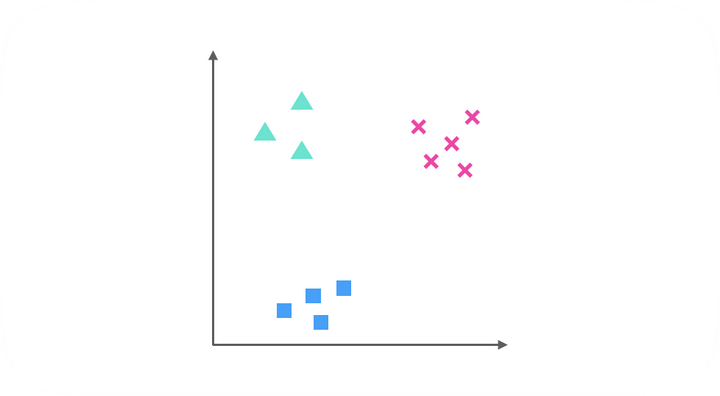
显然,有三个类别,我们可以采用Logistic回归做如下三次分类:
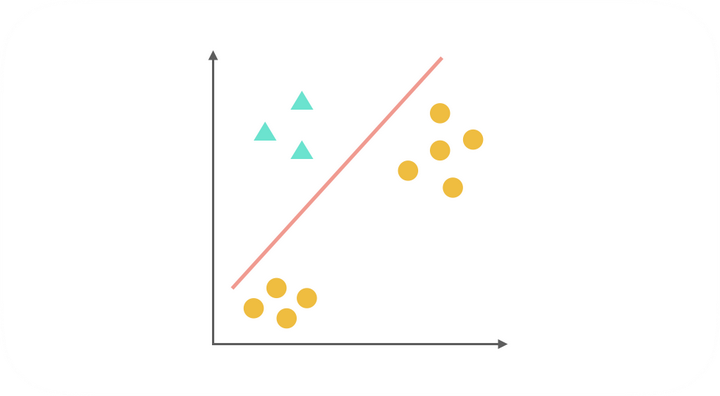
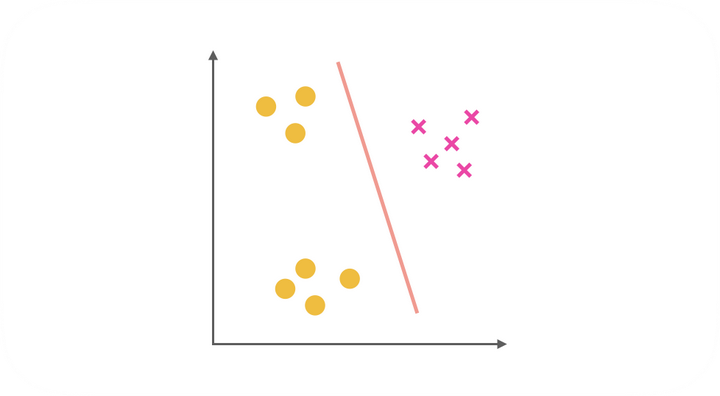

综上,得到了三种二元分类器。在预测阶段,每个分类器根据测试样本得到当前正类(即单独的上图中非黄色的一类)的概率。选择计算结果最高的分类器,其正类就可以作为预测结果。
之前涉及的线性回归和Logistic回归都存在一个问题,即当特征数量很多时,计算负荷会变得特别大。这也是传统机器学习算法一般都具有的问题,例如在图片当中,每个像素点都是一个特征,这对于传统的机器学习是很难解决的。为了应对这种问题,科学家仿照人脑中神经元处理信息的模式,创造了神经网络。
神经网络建立在很多神经元上,每个神经元都是一个处理单元,具有一个激活函数,用来处理接收到的特征,每个神经元有多个输入(类比树突),代表着该神经元接收到了多个特征,每个神经元有一个输出(类比轴突),代表着经过激活函数处理的多种特征的合并,可以理解为对特征进行了提取和改造。其中的轴突和树突(即连接神经元的边)代表着不同的权重。
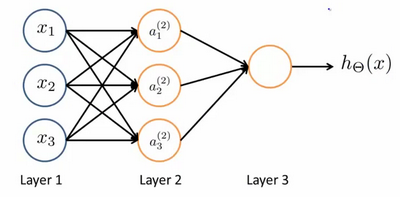
如上图是一个简单的三层神经网络,分为输入层、隐藏层和输出层,输入层就是最原始的特征,每个特征经过加权和喂到了中间层,然后中间层神经元的激活函数对其进行处理,再一次加权送到输出层,这就是前向传播的过程。其中,像之前设计偏置项一样,我们也会为每一层新添一个神经元,做为偏置项:
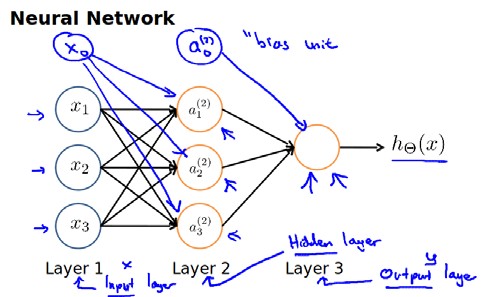
注意,每条边都代表着一个权重,那么我们的参数矩阵Θ要求行数是下一层的神经元个数,列数是本层神经元个数加一。
上图所示的模型,激活单元和输出分别为:
a1(2)=g(Θ10(1)x0+Θ11(1)x1+Θ12(1)x2+Θ13(1)x3)
a2(2)=g(Θ20(1)x0+Θ21(1)x1+Θ22(1)x2+Θ23(1)x3)
a3(2)=g(Θ30(1)x0+Θ31(1)x1+Θ32(1)x2+Θ33(1)x3)
hΘ(x)=g(Θ10(2)a0(2)+Θ11(2)a1(2)+Θ12(2)a2(2)+Θ13(2)a3(2))
这只是考虑一个3维的数据样本,若X为数据集,Θ为网络参数,a为输出,可以得到:
Θ·X=a

For this exercise, you will use logistic regression and neural networks to recognize handwritten digits (from 0 to 9). Automated handwritten digit recognition is widely used today - from recognizing zip codes (postal codes) on mail envelopes to recognizing amounts written on bank checks.
本次实验直接采用scipy中optimize模块中的minimize函数来对损失函数进行优化,与上一个实验不同的地方在于,同时求所有变量的梯度:
# 整体同时求梯度
def gradient(theta, X, y, learning_rate):
error = sigmoid(np.dot(X, theta.T)) - y
grad = (np.dot(X.T, error) / y.shape[0]).T + ((learning_rate / y.shape[0]) * theta)
grad = grad.reshape((-1, 1))
grad[0, 0] = np.sum(error * X[:, 0]) / y.shape[0]
return grad.ravel()
构造k个分类器的函数如下:
def one_vs_all(X, y, k, learning_rate):
"""
分类器函数
:param X: 输入数据,5000 x 400
:param y: 数据对应的标签,5000 x 1
:param k: 需要分类的数量,本次实验k=10(1,2,...,10一共10个数字)
:param learning_rate: 学习率,为惩罚项的系数
:return: all_theta矩阵,每一行是每个分类的所有参数
"""
m = y.shape[0] # 样本数量
params = X.shape[1] # 参数数量
all_theta = np.zeros((k, params+1)) # k x 401(多出的1为截距)
X = np.concatenate((np.ones(m).reshape((m, 1)), X), axis=1) # 扩充了np.ones((5000, 1))
# 分别构造k个分类器
for i in range(1, k + 1):
theta = np.zeros(params + 1).reshape((1, -1))
y_i = np.array([1 if label == i else 0 for label in y])
y_i.reshape((m, 1))
fmin = minimize(fun=cost, x0=theta, args=(X, y_i, learning_rate), method='TNC', jac=gradient)
all_theta[i-1, :] = fmin.x
return all_theta
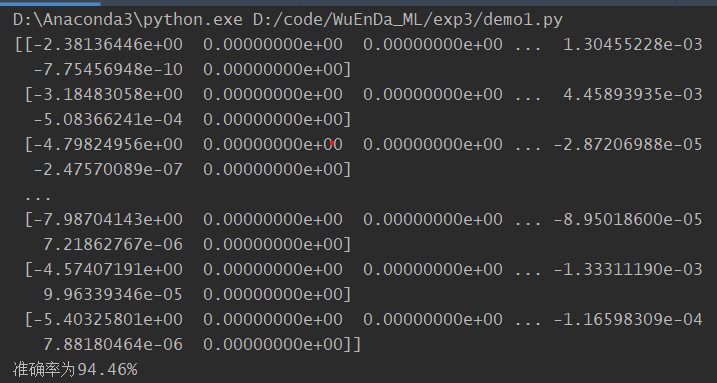
模型准确率为94.46%。
In this part of the exercise, you will implement a neural network to recognize handwritten digits using the same training set as before.Your goal is to implement the feedforward propagation algorithm to use our weights for prediction.
本次实验比较简单,只需要简单地完成前向传播的过程即可。网络参数已经训练好,关键是把握好矩阵乘法的维度和添加偏置项:

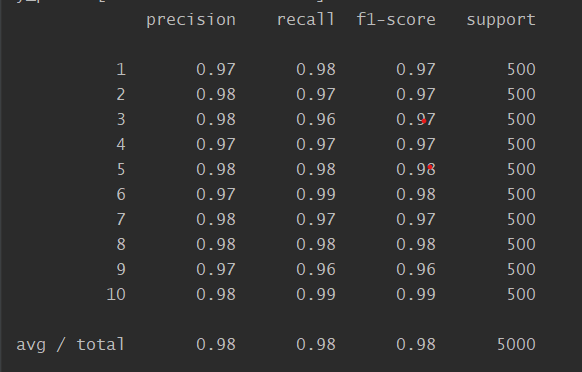
import numpy as np
from scipy.io import loadmat
from scipy.optimize import minimize
data = loadmat('ex3data1.mat')
X = data['X']
y = data['y']
def sigmoid(z):
return 1 / (1+np.exp(-z))
def cost(theta, X, y, learning_rate): # learning_rate为控制惩罚项的参数
y = y.reshape((-1, 1))
theta = theta.reshape((1, -1))
first = -y*np.log(sigmoid(np.dot(X, theta.T)))
second = -(1-y)*np.log(1-sigmoid(np.dot(X, theta.T)))
punish = np.sum(np.power(theta[:, 1:theta.shape[1]], 2))*learning_rate/(2*y.shape[0])
return np.sum(first+second)/y.shape[0] + punish
# 整体同时求梯度
def gradient(theta, X, y, learning_rate):
error = sigmoid(np.dot(X, theta.T)) - y
grad = (np.dot(X.T, error) / y.shape[0]).T + ((learning_rate / y.shape[0]) * theta)
grad = grad.reshape((-1, 1))
grad[0, 0] = np.sum(error * X[:, 0]) / y.shape[0]
return grad.ravel()
def one_vs_all(X, y, k, learning_rate):
"""
分类器函数
:param X: 输入数据,5000 x 400
:param y: 数据对应的标签,5000 x 1
:param k: 需要分类的数量,本次实验k=10(1,2,...,10一共10个数字)
:param learning_rate: 学习率,为惩罚项的系数
:return: all_theta矩阵,每一行是每个分类的所有参数
"""
m = y.shape[0] # 样本数量
params = X.shape[1] # 参数数量
all_theta = np.zeros((k, params+1)) # k x 401(多出的1为截距)
X = np.concatenate((np.ones(m).reshape((m, 1)), X), axis=1) # 扩充了np.ones((5000, 1))
# 分别构造k个分类器
for i in range(1, k + 1):
theta = np.zeros(params + 1).reshape((1, -1))
y_i = np.array([1 if label == i else 0 for label in y])
y_i.reshape((m, 1))
fmin = minimize(fun=cost, x0=theta, args=(X, y_i, learning_rate), method='TNC', jac=gradient)
all_theta[i-1, :] = fmin.x
return all_theta
all_theta = one_vs_all(X, y, 10, 1)
print(all_theta)
# 输出预测结果
def predict(X, all_theta):
m = y.shape[0]
X = np.concatenate((np.ones(m).reshape((m, 1)), X), axis=1)
tmp = sigmoid(np.dot(X, all_theta.T))
pred = (np.argmax(tmp, axis=1) + np.ones(m)).reshape((-1, 1))
return pred
y_pred = predict(X, all_theta) # 预测结果
count = 0 # 计算预测错误的样本个数
for (a, b) in zip(y_pred, y):
if a != b:
count += 1
print('准确率为%.2f%%' % ((1-count/y.shape[0])*100))
import numpy as np
import scipy.io as sio
from sklearn.metrics import classification_report #这个包是评价报告
def sigmoid(z):
return 1 / (1+np.exp(-z))
data = sio.loadmat('ex3data1.mat')
X = data['X']
y = data['y']
weights = sio.loadmat('ex3weights.mat')
Theta1 = weights.get('Theta1')
Theta2 = weights.get('Theta2')
print('Theta1:', Theta1.shape)
print('Theta2:', Theta2.shape)
m = y.shape[0]
X_1 = np.concatenate((np.ones(m).reshape((m, 1)), X), axis=1)
X_2 = np.dot(X_1, Theta1.T)
X_2 = sigmoid(np.concatenate((np.ones(m).reshape((m, 1)), X_2), axis=1))
y_pred = sigmoid(np.dot(X_2, Theta2.T))
y_pred = np.argmax(y_pred, axis=1) + 1
print('y_pred:', y_pred)
print(classification_report(y, y_pred))
Recommend
About Joyk
Aggregate valuable and interesting links.
Joyk means Joy of geeK